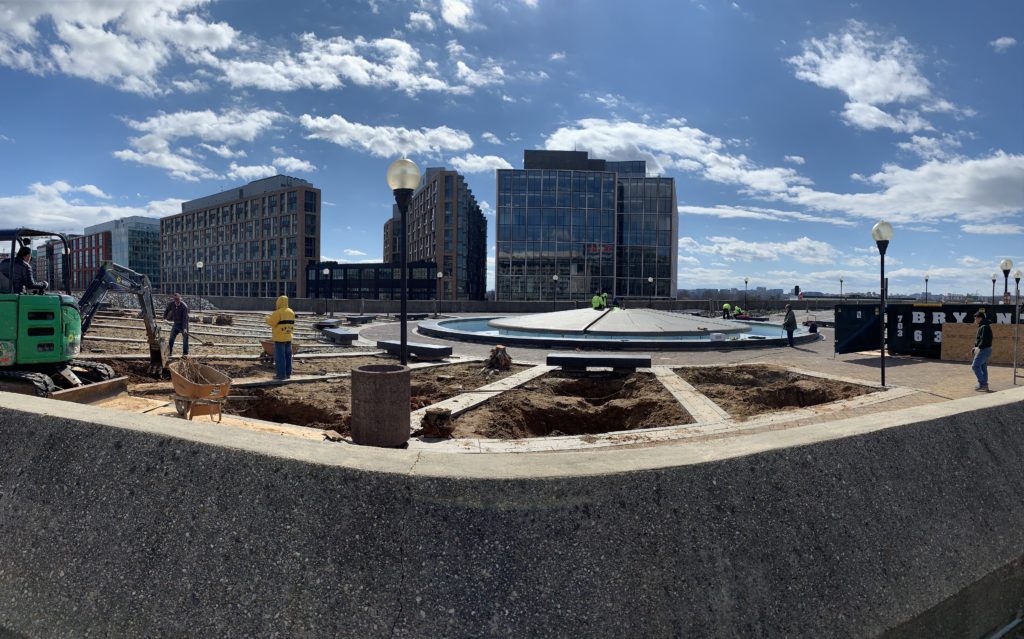By Matt Koehler

Towards the end of January, Southwesters likely noticed that the trees around Banneker Fountain at L’Enfant Plaza had been cut down. The Southwester noticed the community chatter, so we looked into it to find some answers.
Banneker Park and Fountain are getting a much needed upgrade, which should be completed early next month. It’s been about 16 years since Banneker underwent maintenance (2005 and before that in 1997), but the last two makeovers didn’t go far enough. The National Park Service (NPS) said that “there was no substantial rehabilitation for pavement and trees in the overlook area” during the last upgrade. The new repairs will be primarily focused on:
- Repairing and cleaning the masonry
- Updating and optimizing the fountain’s piping and filtration equipment in the mechanical room
- Replacing the trees while installing a deeper soil system that will do a better job at capturing runoff and maintaining the health of the new trees
NPS stated that the total cost of the upgrade will be around $1.1 million.
Banneker Park was built in 1969 and commemorates Benjamin Banneker, an African American scientist, almanac author, surveyor, farmer, who helped in planning the original boundaries of the District of Columbia. The park was designed by Dan Kiley, who also designed Constitution Gardens on the National Mall, among other notable projects. The recently completed Kiley highrise apartment building at 600 Fourth Street SW is named after him. Kiley designed green spaces for the Capitol Park complex of buildings when they were built in the 1960’s.
To get more details about the upgrade at Banneker Park, The Southwester spoke with Jeff Curtis, the Landscape Architect involved in the project, via email.
How long will this project take? Can you provide me details about the total expected cost of the project?
The project is slated to take three months, with an estimated completion at the beginning of May.
What can residents expect in terms of how the area will look while the upgrade is taking place (road closures, etc.)?
The plaza around the fountain will be closed for the duration of the work for safety reasons. But there will be no street closures, and the grassy areas and the stairway that provides access to the waterway will remain open.
What upgrades are being done to the fountain?
We are replacing the fountain jet ring, installing a new filter, replacing the return pipes in the mechanical room, and installing a nanobubble water treatment system, which will use microscopic oxygen bubbles to clean the water without the use of traditional chemicals like chlorine.
I read in the proposal that the soil and space for root growth for trees needed to be improved, can you describe in greater detail the structural changes you will implement to promote the healthy growth of the planned new trees?
The project will replace the compacted subgrade soil beneath the block pavers surrounding the trees with a structural soil system specially designed by Cornell University. This system is basically a mixture of gravel and soil that allows and encourages root growth while still being able to withstand the compression requirements for a paved surface.
Are you just replacing the (now former) landscaping or will it be reimagined?
This project is a renovation of the existing park, not a redesign. The National Park Service is typically tasked with maintaining the look of the land that it manages and this will not be an exception. The area will look more or less the same, but in a better, more sustainable condition, including a fountain that works better, repaired masonry and better looking, healthier trees.
Any particular part of the project that you’re most excited about?
I’m most excited about the work that is being done with the trees. The original 1970s’ design of the memorial did not account for the soil requirement of the trees planted there, so we have had to replace them every five to 10 years where the lifespan of a London Plane tree in good conditions can easily be over 100 years. The new soil system utilizes technology and understanding that has been developed within the last couple decades. It won’t get the trees to the full potential of a tree in an uncompacted open field or forest, but it will be a big improvement.
Something I missed?
It might be worth noting that although the park has undergone two major rehabilitations (in 1997 and 2005), this is the first major work on the pavement and trees in the overlook area since the park was built in 1969.

